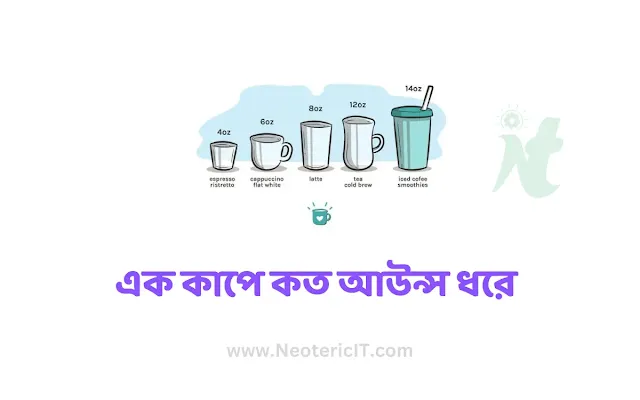How many ounces in a cup - cup to ounces
Hello dear guest - Welcome to Neoteric IT . You have come to Neoteric IT for information about How many ounces in a cup - cup to ounces Today I will conclude this article by discussing How many ounces in a cup - cup to ounces in detail. Search Google to know more about How many ounces in a cup - cup to ounces write How many ounces in a cup - cup to ounces or click here insightflowblog.com for visit. See the page Table of content for know the main topic of this article. Web story and AMP Version
How many ounces a cup holds depends on the type, size, and volume of the cup. Typically, a measuring cup holds 8 ounces. However, a tea cup holds about 6 ounces, a coffee cup holds about 4 ounces, and a soup cup holds about 10 ounces.
How many ounces in a cup - cup to ounces - neotericit.com
measuring cup
A measuring cup is a special type of cup used to measure quantities of food and drink. A measuring cup usually holds 8 ounces. It consists of two main parts: a larger one, which is used to measure liquids, and a smaller one, which is used to measure dry ingredients.
cup of tea
A teacup is a small cup used to drink tea. A teacup holds about 6 ounces. It is usually half the size of an 8 ounce measuring cup.
coffee cup
A coffee cup is a small cup used to drink coffee. A coffee cup holds about 4 ounces. It is usually one-third the size of an 8-ounce measuring cup.
cup of soup
A soup cup is a large cup used to drink soup. A soup cup holds about 10 ounces. It is usually about one-tenth the size of an 8-ounce measuring cup.
How many ounces a cup holds depends on the type, size, and volume of the cup. Typically, a measuring cup holds 8 ounces. However, a tea cup holds about 6 ounces, a coffee cup holds about 4 ounces, and a soup cup holds about 10 ounces.
How many ounces does a cup hold?
When it comes to cooking and baking, precise measurements are paramount to achieving consistent and successful results. A basic question that often arises is, "How many ounces are in a cup?" There's more to this seemingly straightforward question than meets the eye, as the answer can vary depending on context and the specific cup in question. In this article, we'll explore the different standards for measuring cups and the importance of understanding these differences in the culinary world.
Standard cup measurements
In the United States, the standard cup measurement is widely accepted as 8 fluid ounces. This means that one cup is capable of holding 8 fluid ounces of fluid. This standard is used in most recipes and cooking instructions across the country, making it a reliable benchmark for American cooks and bakers.
However, it is very important to distinguish between fluid ounces (volume) and ounces (weight). They are not the same and are easy to confuse. Although a cup may hold 8 ounces of liquids, it does not necessarily hold 8 ounces of solids such as sugar or flour. The weight of a cup of a solid material can vary significantly based on its density.
Metric cup measurements
Unlike the United States, the metric system uses a different cup measurement. In most metric countries, including Australia and parts of Europe, a standard metric cup contains 250 milliliters (mL), which is equivalent to 250 grams or about 8.45 fluid ounces. The metric cup is often used in recipes from this region, and if you're following recipes from a metric country, it's essential to be aware of this difference.
Imperial cup measurement
The United Kingdom has its own cup measurement, known as the imperial cup, which holds 284 milliliters, or about 10 imperial fluid ounces. This means that a cup used in the UK is slightly larger than a standard American cup.
Conversion and precision measurements
To avoid confusion and measurement errors, it is recommended to be aware of the specific cup measurements used in a recipe or use a kitchen scale for precise measurements. In some cases, recipes will provide both volume and weight measurements for ingredients to ensure accuracy.
For example, if a recipe calls for one cup of flour, it's best to weigh it if you want to be sure of the exact amount, as the weight of a cup of flour can vary depending on moisture and the method of filling the cup.
In conclusion
The question of how many ounces a cup holds may seem straightforward, but it can cause confusion due to the different cup measurements used in different parts of the world. In the United States, a standard cup contains 8 fluid ounces, while other countries use metric or imperial cup measurements, which are slightly different. It's important to be aware of these differences when following recipes from different regions and understanding the difference between fluid ounces and ounces by weight. By doing so, you will be better equipped to navigate the diverse culinary landscape and achieve consistent and delicious results in your cooking and baking endeavors.
Thanks for read the post. You can also read the article in bangla - cup-to-ounces
You are indeed a valued reader of Neoteric IT. Thank you so much for reading How many ounces in a cup - cup to ounces article. Please let us know how you feel after reading this article.

 Follow Google News to get the latest Neoteric IT news
Follow Google News to get the latest Neoteric IT news 
.png)





Please comment in accordance with the policy - otherwise your comments will not be accepted.
comment url